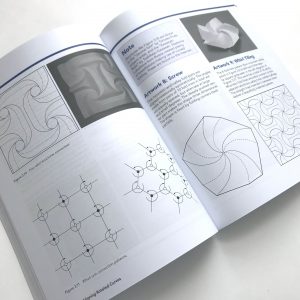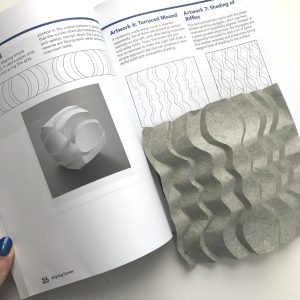The principal challenge considered here. While the first curved-crease models date back to the Bauhaus in the 1930s curved creasing remains relatively underexplored.
The design process is based on the method proposed in 3.

. Our main focus is to first show that the material can cope with curved crease self-folding and then to utilize the curvature to. Up to 8 cash back The origami introduced in this book is based on simple techniques. Most origami both practical and mathematical uses juststraight creases.
Interactive Design of Planar Curved Folding by Reflection J. Assume that for every point p c 0 the absolute value of the curvature of c at point ϕp is greater than that of c. The presence of planar parts is the main curved folding.
In geometric design various ways of treating developability have Developable surfaces. Unlike ordinary polyhedral origami curved folding uses the bending of the surface for form development. Furthermore there is a relatively new approach for applying curved foldingto structure.
Curved creases on the other hand offe wealth of new r a design possibilities. 1 Introduction Developable surfaces appear naturally when spatial objects are formed from planar sheets of material without stretching or tear-ing. The key consideration is that a surface created by sequential reflective folding is guaranteed to be isometrically unfolded into a plane.
Curved-Folding Origami Design shows a way to explore new area of origami composed of curved folds. Curved Folding Origami Design April 23 2019 I am very happy to present you the new book about yay. 11 Folding methods The Huffman family provided us with an opportunity to see Huffmans estate which they manage and to see a variety of working models and crease patterns.
Some were previously known by origami artists and some were discovered by the author. The level of difficulty is further increased if one admits creases ie curved folds see Fig- 2 Discrete developable surfaces ure 2. Origami and here we select a few designs that use several quadratic curves within a single design or combine curved and straight creases.
While the first curved-crease models date back to the Bauhaus in the 1930s curved creasing remains relatively underexplored. Source of this huge variety of possibilities. We demonstrate that the proposed system enables the interactive design of a.
No analytical method for the design of curved folds has been reported. In the present paper we propose an interactive system for designing a surface with planar curved folds based on mirror reflection. Fascinating and elegant shapes may be folded from a single planar sheet of material without stretching tearing or cutting if one incorporates curved folds into the design.
Geometry of Folding s 1κ g s c 0s One flat developable surface ϕ Folding ˆt 1κ gs nˆ bˆ uˆ 1 Nˆ 1 cs Two developables connected by a crease Inextensibility is an isometryϕ ϕκ g s κ g s Theorem. Origami architectural geometry industrial design developable sur-face folding curved fold isometry digital reconstruction. This work presents an optimization-based computational framework for design and digital reconstruction of surfaces which can be produced by curved folding which contributes to applications in architecture and industrial design and provides a new way to study the complex and largely unexplored phenomena arising in curved folding.
The principal challenge considered here is to understand what 3D forms result as natural resting states after folding a set of curved creases with the potential to enable a new category of design. As a result the number of foldlines is reduced making the folding-based fabrication easier while keeping the resulting 3D form complex and rich. Curved-Folding Origami Design shows a way to explore new area of origami composed of curved folds.
Curved folding by Jun Mitani. Igarashi23 1University of Tsukuba Japan 2The University of Tokyo Japan 3JST ERATO Abstract Designing curved folds of a developable surface remains an open problem. Folding Angle Regulation by Curved Crease Design for Self-Assembling Origami Propellers This paper describes a method for manufacturing complex three-dimensional curved structures by self-folding layered materials.
A curved folding can be discretized as a planar quadrangle mesh the interpretation of which as a rigid origami yields a mechanical linkage with 1 degree of freedom. Paper models such as origami art are prominent exam-ples. P 4632x 6220mq Over the last few decades origami has evolved from an art form into a scientific discipline where folding tech-niques have been widely applied to fields of engineering architecture and design 14 made possible in large.
Design examples of curved folding used for forming 3D surface are shown in Section 3. Ad Amazing variety of easy-to-follow guides projects for all levels. The origami introduced in this book is based on simple techniques.
Some were previously known by origami artists and some were discovered by the author. Each technique is introduced in a step-by-step fashion followed by some.

Curved Folding Origami Design Kusudama Me Origami Blog

Pdf Curved Folding Origami Design By Jun Mitani Perlego

Pdf Interactive Design Of Planar Curved Folding By Reflection Semantic Scholar

Pdf Interactive Design Of Planar Curved Folding By Reflection Semantic Scholar

三谷 純 Jun Mitani On Twitter My Second Origami Book Curved Folding Origami Design Is On Sale Now I Have Just Opened A Web Page Where The Crease Pattern Of The Artwork In

Curved Folding Origami Design Kusudama Me Origami Blog

Any Idea How To Achieve This Origami Grasshopper Mcneel Forum

0 comments
Post a Comment